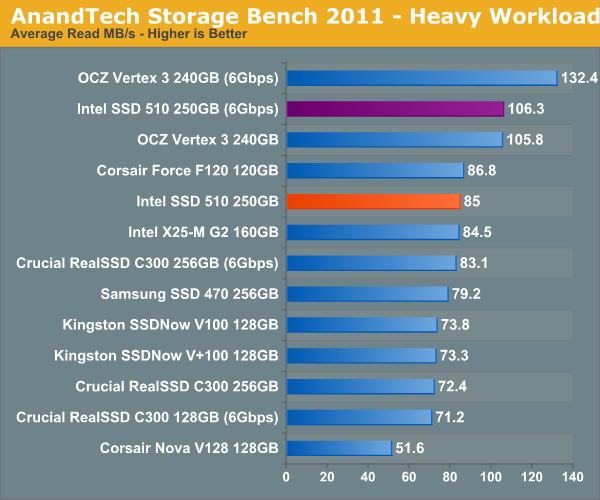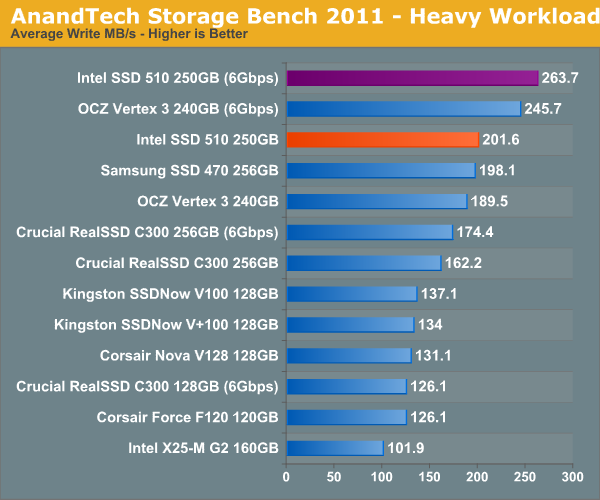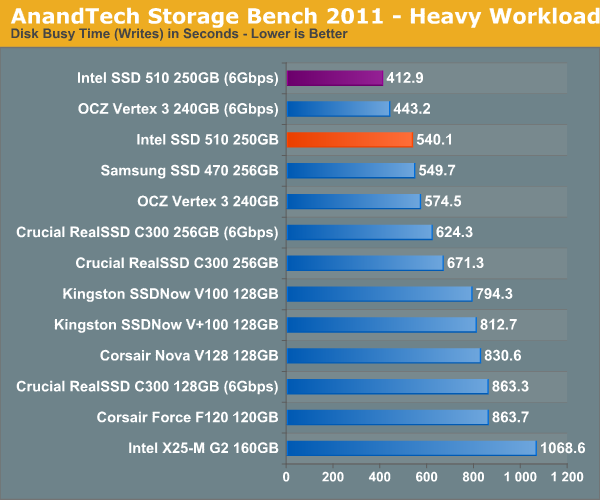The Intel SSD 510 Review
by Anand Lal Shimpi on March 2, 2011 1:23 AM EST- Posted in
- IT Computing
- Storage
- SSDs
- Intel
- Intel SSD 510
AnandTech Storage Bench 2011: Much Heavier
I didn't expect to have to debut this so soon, but I've been working on updated benchmarks for 2011. Last year we introduced our AnandTech Storage Bench, a suite of benchmarks that took traces of real OS/application usage and played them back in a repeatable manner. I assembled the traces myself out of frustration with the majority of what we have today in terms of SSD benchmarks.
Although the AnandTech Storage Bench tests did a good job of characterizing SSD performance, they weren't stressful enough. All of the tests performed less than 10GB of reads/writes and typically involved only 4GB of writes specifically. That's not even enough exceed the spare area on most SSDs. Most canned SSD benchmarks don't even come close to writing a single gigabyte of data, but that doesn't mean that simply writing 4GB is acceptable.
Originally I kept the benchmarks short enough that they wouldn't be a burden to run (~30 minutes) but long enough that they were representative of what a power user might do with their system.
Not too long ago I tweeted that I had created what I referred to as the Mother of All SSD Benchmarks (MOASB). Rather than only writing 4GB of data to the drive, this benchmark writes 106.32GB. It's the load you'd put on a drive after nearly two weeks of constant usage. And it takes a *long* time to run.
I'll be sharing the full details of the benchmark in some upcoming SSD articles but here are some details:
1) The MOASB, officially called AnandTech Storage Bench 2011 - Heavy Workload, mainly focuses on the times when your I/O activity is the highest. There is a lot of downloading and application installing that happens during the course of this test. My thinking was that it's during application installs, file copies, downloading and multitasking with all of this that you can really notice performance differences between drives.
2) I tried to cover as many bases as possible with the software I incorporated into this test. There's a lot of photo editing in Photoshop, HTML editing in Dreamweaver, web browsing, game playing/level loading (Starcraft II & WoW are both a part of the test) as well as general use stuff (application installing, virus scanning). I included a large amount of email downloading, document creation and editing as well. To top it all off I even use Visual Studio 2008 to build Chromium during the test.
Many of you have asked for a better way to really characterize performance. Simply looking at IOPS doesn't really say much. As a result I'm going to be presenting Storage Bench 2011 data in a slightly different way. We'll have performance represented as Average MB/s, with higher numbers being better. At the same time I'll be reporting how long the SSD was busy while running this test. These disk busy graphs will show you exactly how much time was shaved off by using a faster drive vs. a slower one during the course of this test. Finally, I will also break out performance into reads, writes and combined. The reason I do this is to help balance out the fact that this test is unusually write intensive, which can often hide the benefits of a drive with good read performance.
There's also a new light workload for 2011. This is a far more reasonable, typical every day use case benchmark. Lots of web browsing, photo editing (but with a greater focus on photo consumption), video playback as well as some application installs and gaming. This test isn't nearly as write intensive as the MOASB but it's still multiple times more write intensive than what we were running last year.
As always I don't believe that these two benchmarks alone are enough to characterize the performance of a drive, but hopefully along with the rest of our tests they will help provide a better idea.
The testbed for Storage Bench 2011 has changed as well. We're now using a Sandy Bridge platform with full 6Gbps support for these tests. All of the older tests are still run on our X58 platform.
AnandTech Storage Bench 2011 - Heavy Workload
We'll start out by looking at average data rate throughout our new heavy workload test:

There's simply no dethroning the Vertex 3, but Intel's SSD 510 does come dangerously close. Over a 6Gbps interface the 510 delivers 93% of the performance of the Vertex 3. Over a 3Gbps interface the gap narrows to a meager 5.2%.
The breakdown of reads vs. writes tells us more of what's going on:

The Vertex 3 is nearly 25% faster than the 510 if we just isolate the reads conducted by our benchmark. Remember the poor random read performance? I suspect that's at play here. The Intel SSD 510 on a 6Gbps interface is about the speed of the Vertex 3 on a 3Gbps port.

Ah ha! This is where the picture shifts. Our heavy workload does have a significant amount of incompressible writes which significantly reduce the performance of the Vertex 3. The V3 loses enough ground that the 510 is 7% faster in writes during our benchmark.
The next three charts just represent the same data, but in a different manner. Instead of looking at average data rate, we're looking at how long the disk was busy for during this entire test. Note that disk busy time excludes any and all idles, this is just how long the SSD was busy doing something:













128 Comments
View All Comments
Marlin1975 - Wednesday, March 2, 2011 - link
How about throwing in a AMD SB850 to see how they handle SSD's.AMD has had native SATA6gb longer than intel so like to see how that matchs up. Most only look at CPU and ignore the chipset.
DarkKnight_Y2K - Wednesday, March 2, 2011 - link
+1tech6 - Wednesday, March 2, 2011 - link
So nothing has really changed. There still isn't one "perfect" SSD that does everything well and is proven to be reliable. I guess the disappointment stems from many that were hoping that the new Intel SSDs would tick all those boxes - speed, reliability and price. As usual YMMV - Samsung and Intel is the conservative choice and SF based drives are for those who want maximum performance in random I/O situations.tno - Wednesday, March 2, 2011 - link
This, as always in the tech world, is a numbers and marketing game. Somewhere there is a user who is encoding video and really needs the bleeding edge for that. There is an artist working on large incompressible canvasses in Photoshop. These guys need this drive. They have a small Sandforce doing OS duties but they need a fast non -Sandforce drive for data. All those numbers mean squat without perspective and that's what's the text of Anandtech articles bring.So maybe for the consumer that is tech savvy enough to know they want an SSD but not enough to have read all that has been published with regards SSD drives they need a simple primer. Maybe a web app. Do you use you computer with VMs? Do you use it with games? Is your computer a netbook? I'm certain there is a way to ask a few questions and come up with a sensible suggestion for what drive is right for which user.
That would only work with a more comprehensive field of tested drives. Other posters are right, there is little to no way of knowing which is the best 40GB drive. So I volunteer myself to help. Anand, I am a soon to be new father that would love to work from home if for no other reason than daycare costs nearly as much as what I get paid as a paramedic. Send me a system, every SSD on the market and a small stipend and I will test anything and everything solid state.
Gigantopithecus - Wednesday, March 2, 2011 - link
...with poor product differentiation. With Intel's adoption of the same controller others are using, SSDs become that much less interesting. I realize firmware and QC differences still exist, but without hard numbers (aside from the French site's), and given that major snafus can hit any maker at any time, it seems like the only real consideration is ye ole customer service. I've dealt with OCZ's 'support' department twice and that was enough for me. Intel and Crucial have always treated me right, so considering real world performance differences more or less don't exist anymore, they'll be getting my SSD $s.LeeKay - Wednesday, March 2, 2011 - link
have had 100% Faliure and i have had 5 drives all failed.iwod - Wednesday, March 2, 2011 - link
I have been asking the question for a long time. Why an Toshiba SSD manage to beat Sandforce in some real world usage. And finally we got an answer.Given all SSD latency are roughly equal or the same.
Seq Read Write is EXTREMELY Important in Everyday usage. IT IS THE SINGLE MOST Important factor that gives you most improvement in SSD Real World usage benchmarks.
Random Write reaches the top with 50 MB/s. And while we would want further reduction in Write latency, but with the increase of Ram / Cache onbroad with SSD. This should not be an issue.
Random Read results shows we have still some head room to grow.
With further tweaking Intel may be able to squeeze out even more performance our of it.
tno - Thursday, March 3, 2011 - link
I think I missed something, while Seq Read Write is obviously the big number that makes the marketing materials, in terms of user experience (ooh, buzzword) the Random Reads are where lies the money, and as Anand said in the article, no modern OS stresses this enough to make the lower numbers a significant limitation.High sequential reading and writing is only going to be felt by those that are moving large files around within an already fast environment where a mechanical disk drive would be a bottle neck (encoding files locally for instance). And while for those users Seq Read Write might be considered "THE SINGLE MOST important factor" it wouldn't be for, say, the person that wants to add some oopmh to a dual-core laptop of otherwise mediocre specifications.
Certainly, aside from playing around with transferring files, my drives have probably never approached their max seq speed. As OS drives, they mainly spend their time hunting out small files for the OS to use.
Beenthere - Wednesday, March 2, 2011 - link
These SSDs aren't ready for prime time just yet IMO. Maybe in another 2-3 years?tno - Thursday, March 3, 2011 - link
What's the hold up? Reliability? Speed?